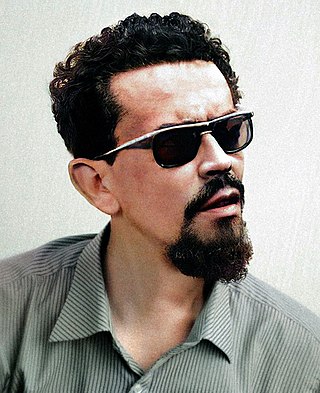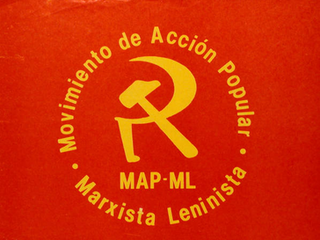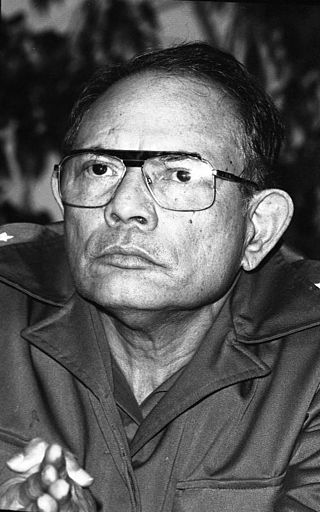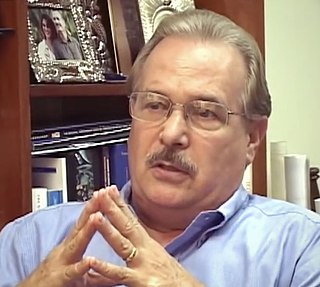
The Sandinista National Liberation Front is a Christian socialist political party in Nicaragua. Its members are called Sandinistas in both English and Spanish. The party is named after Augusto César Sandino, who led the Nicaraguan resistance against the United States occupation of Nicaragua in the 1930s.

The Somoza family is a political family which ruled Nicaragua for forty-three years – from 1936 to 1979. Their family dictatorship, founded by Anastasio Somoza García, was continued by his two sons Luis Somoza Debayle and Anastasio Somoza Debayle. Anastasio Somoza García served as the President of Nicaragua from 1937 until 1956. He was succeeded by his elder son, Luis Somoza Debayle, who held the presidency from 1957 to 1963. The younger Somoza son, Anastasio Somoza Debayle, had two presidential terms: 1967–1972 and 1974–1979. Although the Somozas did not hold the presidency for the full forty-three years, they continued to rule through puppet presidents and via their control of the National Guard.

The Nicaraguan Revolution began with rising opposition to the Somoza dictatorship in the 1960s and 1970s, the ouster of the dictatorship in 1978–79, and fighting between the government and the Contras from 1981 to 1990. The revolution revealed the country as one of the major proxy war battlegrounds of the Cold War.

Carlos Fonseca Amador was a Nicaraguan professor, politician, writer and revolutionary who was one of the founders of the Sandinista National Liberation Front (FSLN). Fonseca was later killed in the mountains of the Zelaya Department, Nicaragua, three years before the FSLN took power. He has posthumously received the titles of National Hero of Nicaragua and Commander in Chief of the Sandinista Popular Revolution.

Popular Action Movement - Marxist–Leninist is a Hoxhaist communist party in Nicaragua that surged out of a split from the Sandinista National Liberation Front (FSLN) in the early 1970s. Since 1985 it is officially named the Marxist–Leninist Party of Nicaragua, but the original name MAP-ML is far more known and has been used when participating in elections.

Carlos Mejía Godoy is a Nicaraguan musician, composer and singer-songwriter and one of the main representatives of the testimonial song or new song of his country.
Patricio José Argüello Ryan, commonly referred to simply as Patrick Argüello, was a Nicaraguan-American Marxist–Leninist militant. He was a member of the Sandinista National Liberation Front (FSLN), and is best-known for his unsuccessful hijacking of El Al Flight 219 alongside Palestinian militant Leila Khaled on September 6, 1970. Flight 219 was an international civilian passenger flight from Tel Aviv to New York City that was hijacked by the duo shortly after it took off from a stopover in Amsterdam. Argüello and Khaled, acting on part of a larger series of hijackings by the Popular Front for the Liberation of Palestine (PFLP), ultimately failed to take control of the plane due to heavy resistance from the passengers and security, who subdued the duo after pilot Uri Bar-Lev had thrown them off balance by putting the plane into a steep nosedive. Bar-Lev then made an emergency landing at Heathrow Airport in London, where Argüello was shot multiple times, later succumbing to his injuries. The FSLN had agreed to support the PFLP's hijackings in exchange for guerrilla warfare training.
La Libertad is a municipality in the Chontales Department of Nicaragua. It is the birthplace of President Daniel Ortega, Cardinal Miguel Obando y Bravo, and Vice President Omar Halleslevens. It has a population of 14,712 people.

Rigoberto López Pérez was a Nicaraguan poet, artist and composer. He assassinated Anastasio Somoza García, the longtime dictator of Nicaragua.
Sandinista ideology or Sandinismo is a series of political and economic philosophies instituted by the Nicaraguan Sandinista National Liberation Front throughout the late twentieth century. The ideology and movement acquired its name, image and its military style from Augusto César Sandino, a Nicaraguan revolutionary leader who waged a guerrilla war against the United States Marines and the conservative Somoza National Guards in the early twentieth century. The principals of modern Sandinista ideology were mainly developed by Carlos Fonseca, inspired by the leaders of the Cuban Revolution in the 1950s. It sought to inspire socialist populism among Nicaragua's peasant population. One of these main philosophies involved the institution of an educational system that would free the population from the perceived historical fallacies spread by the ruling Somoza family. By awakening political thought among the people, proponents of Sandinista ideology believed that human resources would be available to not only execute a guerrilla war against the Somoza regime but also build a society resistant to economic and military intervention imposed by foreign entities.
Women played a role in the Nicaraguan Revolution. Those who joined the Sandinista movement in the revolutionary Nicaragua essentially fought a battle: to secure national freedom from the Somoza dictatorship and to advance gender equality.

Arturo José Cruz Porras, sometimes called Arturo Cruz Sr. to distinguish him from his son, was a Nicaraguan banker and technocrat. He became prominent in politics during the Sandinista (FSLN) era. After repeatedly resigning from positions in protest, opinion divided between those who lauded him as a statesman and man of principle, and those who derided him as an ineffectual hand-wringer.

Tomás Borge Martínez, often spelled as Thomas Borge in American newspapers, was a cofounder of the Sandinista National Liberation Front in Nicaragua and was Interior Minister of Nicaragua during one of the administrations of Daniel Ortega. He was also a renowned statesman, writer, and politician. Tomás Borge also held the titles of "Vice-Secretary and President of the FSLN", member of the Nicaraguan Parliament and National Congress, and Ambassador to Peru. Considered a hardliner, he led the "prolonged people's war" tendency within the FSLN until his death.

Joaquín Cuadra Lacayo a scion of Nicaragua's elite, joined the rebel Sandinista National Liberation Front (FSLN) in late 1972. After their victory in 1979, he became army chief of staff.

The Sandinista Popular Army (SPA) was the military forces established in 1979 by the new Sandinista government of Nicaragua to replace the Nicaraguan National Guard, following the overthrow of Anastasio Somoza Debayle.
In 1979, the Sandinista National Liberation Front (FSLN) overthrew Anastasio Somoza Debayle, ending the Somoza dynasty, and established a revolutionary government in Nicaragua. Following their seizure of power, the Sandinistas ruled the country first as part of a Junta of National Reconstruction. Following the resignation of centrist members from this Junta, the FSLN took exclusive power in March 1981.
Rigoberto was a 1945 Argentine comedy film.

Luis Fernando Carrión Cruz is Nicaraguan politician. He is a former guerilla and one of the nine commandantes of the Sandinista (FSLN) National Directorate that overthrew the Somoza regime in 1979. Born to a wealthy, politically-connected family, he began college in the United States but returned to Nicaragua, first joining a radical Catholic group then the FSLN. He led the Carlos Roberto Huembes Eastern Front in Chontales during the final offensive of the revolution. He was a government minister and member of the FSLN National Directorate until 1995 when he split with party and became a cofounder of the Sandinista Renovation Movement (MRS).

Petrona Hernández López, born Maria de la Cruz, better known as Amanda Aguilar, was a revolutionary from Nicaragua.












